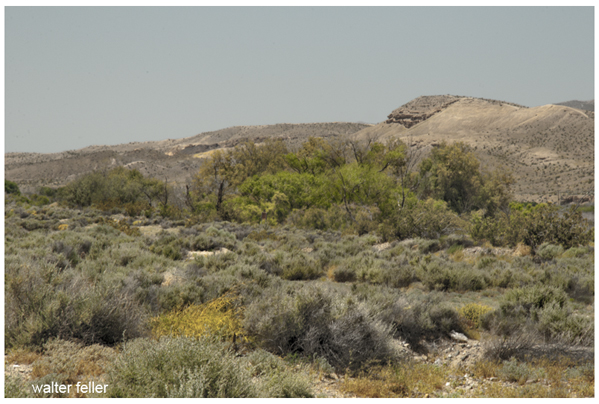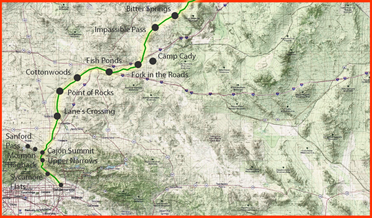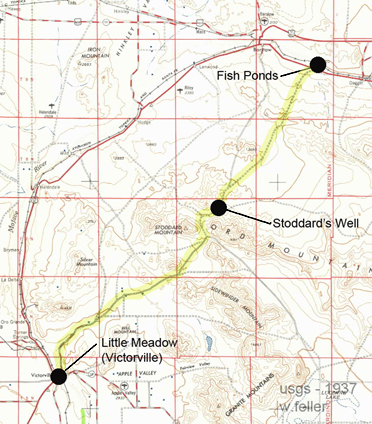Fish Ponds
"Fish Ponds, Salt Lake Trail/Mojave River Trail" relates to the historical routes and natural features along the Mojave River, significant for their roles in early travel and settlement in the Mojave Desert region.
The Fish Ponds were a series of natural and artificial ponds found along the Mojave River. These ponds historically provided vital water sources for travelers and settlers. The presence of fish in these ponds made them even more valuable as a resource for sustenance in an otherwise arid environment. The ponds supported a variety of aquatic life and were essential stops for both Native Americans and early European explorers.
Salt Lake Trail/Mojave River Trail
The Salt Lake Trail, also known as the Mormon Trail, and the Mojave River Trail were crucial routes for westward expansion. They were part of the network of trails that connected the interior of the United States to the Pacific Coast.Salt Lake Trail (Mormon Trail):
This trail was primarily used by Mormon pioneers traveling from Salt Lake City to Southern California. It followed a path that offered the most reliable sources of water, which included the Mojave River and its associated ponds and springs. The trail was integral to the migration and settlement patterns in the mid-19th century.Mojave River Trail:
This ancient trail was used by Native Americans long before European settlers arrived. It follows the Mojave River from its headwaters in the San Bernardino Mountains, across the Mojave Desert, and toward the Colorado River. The trail provided a reliable route through the desert, with water and resources available at intervals along the river. These trails were not only vital for migration and settlement but also for trade and communication between different regions. The Mojave River Trail, in particular, was used for centuries by various groups, including the Paiute, Mojave, and Serrano tribes, as well as Spanish missionaries and explorers.Historical Significance
Native American Usage:
The Mojave River Trail was used by Native American tribes for trade, travel, and communication. They knew the locations of water sources and could navigate the challenging desert terrain.European Exploration:
Spanish explorers and missionaries, such as Father Francisco GarcÚs in the late 18th century, used these trails to establish missions and trade routes.Westward Expansion:
During the mid-19th century, these trails became critical for pioneers, particularly the Mormons, who sought new lands in California. The trails provided a relatively safe and reliable route through the harsh desert.Modern Impact
The Fish Ponds were wiped out by floods long ago. Today, the history of these trails is preserved in various landmarks and historical sites. The Mojave River still plays a crucial role in the ecology of the region, and the trails are remembered for their significant contributions to the development of the American West.These trails and natural features like the Fish Ponds are part of the rich tapestry of history and natural history in the Mojave Desert, illustrating the interplay between human activity and the environment over centuries.
The Marine Corps Logistics Base Barstow (Nebo) encompasses a historical spot called fish ponds which was a stop for many early travelers coming through the area to include the Mormon migration of 1851. upon its location along one of the main roads into Southern California, but in the late 1860s a rival road was put into place, Lafayette Mecham, who operated a station at Fish Ponds. the natural pond in the Mojave River at that point abounded with fish. He raised hay and grain for the travelers, repaired wagons in supplied leather to mend harness. Those desert stations were a predecessor to the general store of the later villages. it took away some of the commerce that made the crossing such desirable real estate.
Mecham's Road from Fish Ponds
The settlement of Lane v Andrews in 1869 freed the upper crossing property for resale, but at that time changes occurred that would affect the value of the ranch, and it was likely Lane had to settle for something less than the price agreed to by Andrews. The value of the property had been dependent, to a great extent, and it took away some of the commerce that made the crossing such desirable real estate.
Heritage of the Mojave River Valley

Mojave Road
Stoddard Wells Road
Salt Lake Road

